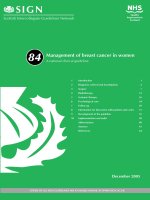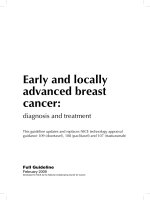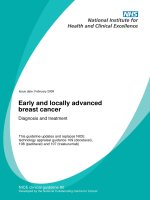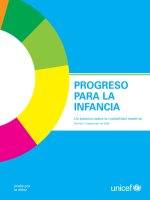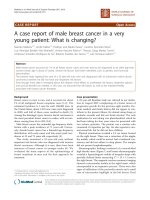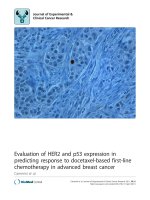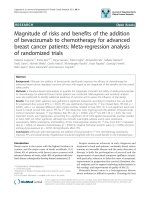Factors influencing diagnosis delay of advanced breast cancer in Moroccan women
Bạn đang xem bản rút gọn của tài liệu. Xem và tải ngay bản đầy đủ của tài liệu tại đây (441.86 KB, 8 trang )
Maghous et al. BMC Cancer (2016) 16:356
DOI 10.1186/s12885-016-2394-y
RESEARCH ARTICLE
Open Access
Factors influencing diagnosis delay of
advanced breast cancer in Moroccan
women
A. Maghous1*, F. Rais1, S. Ahid3, N. Benhmidou1, K. Bellahamou2, H. Loughlimi1, E. Marnouche1, S. Elmajjaoui1,
H. Elkacemi1, T. Kebdani1 and N. Benjaafar1
Abstract
Background: Delay in the diagnosis of breast cancer in symptomatic women of 3 months or more is associated
with advanced stage and low survival. We conducted this study to learn more about the extent and reasons
behind diagnosis delay of advanced breast cancer in Moroccan women.
Methods: A group of patients with advanced breast cancer were interviewed at the National Institute of Oncology in
Rabat during the period from February to December 2014. Diagnosis delay was devised into patient delay and system
delay. Patient delay was defined as time from first symptoms until first medical consultation. System delay was defined
as time from first presentation to a health care provider until definite diagnosis or treatment. Prospective information
and clinical data were collected on a form during an interview with each patient and from medical records.
Results: In all, 137 patients were interviewed. The mean age of women was 48.3 ± 10.4 years. The median of
consultation time was 6[4,12] months and the median of diagnosis time was 1[1,3] months. Diagnosis delay was
associated to a personal reason in 96 (70.1 %) patients and to a medical reason in 19 (13.9 %) patients. A number of
factors predicted diagnosis delay: symptoms were not considered serious in 66 (55.9 %) patients; traditional therapy
was applied in 15 (12.7 %) patients and fear of cancer diagnosis and/or treatment in 14 (11.9 %) patients. A use of
traditional methods was significantly associated with rural residence and far away from basic health center (p = 0.000).
Paradoxically, a family history of breast cancer was significantly higher in who report a fear of cancer diagnosis and/or
treatment to diagnosis delay (p < 0.001). Also, a significantly higher risk of more than 6 months delay was found
among rural women (P = 0.035) and women who live far away from specialized care center (P = 0.001).
Conclusions: Diagnosis delay is very serious problem in Morocco. Diagnosis delay was associated with complex
interactions between several factors and with advanced stages. There is a need for improving breast cancer information
in our populations and training of general practitioners to reduce advanced breast cancer by promoting early detection.
Keywords: Breast cancer, Diagnosis delay, Patient delay, System delay
Background
Breast cancer is the most frequently occurring cancer
in women all over the world with nearly a half million deaths each year [1]. It is now the most common
cancer both in developed and developing regions. In
Morocco, breast cancer represents a serious public
health problem. It’s the first cancer among women
* Correspondence:
1
Department of radiotherapy, National Institute of Oncology, Mohammed V
University in Rabat, Rabat, Morocco
Full list of author information is available at the end of the article
with a standardized incidence of 49.2 for an average
age of 50 years according to 2006–2008 data reported
by the Rabat Cancer Registry [2].
Longer waiting times prior to diagnosis and the initiation of therapy are likely to result in advanced disease
and low survival [3–5]. The delayed diagnosis is more
responsible rather than the disease itself in causing mortality of the patient, as early diagnosis and treatment is
associated with better prognosis when compared to
worse outcomes related to significantly delayed diagnosis. For example, studies in developed and developing
© 2016 The Author(s). Open Access This article is distributed under the terms of the Creative Commons Attribution 4.0
International License ( which permits unrestricted use, distribution, and
reproduction in any medium, provided you give appropriate credit to the original author(s) and the source, provide a link to
the Creative Commons license, and indicate if changes were made. The Creative Commons Public Domain Dedication waiver
( applies to the data made available in this article, unless otherwise stated.
Maghous et al. BMC Cancer (2016) 16:356
countries reported that a diagnosis delay of more than
3 months occurred in 14–53 % of cases [6–15]. Low
socio-economic status, minority ethnicity and young age
were associated with a longer duration of symptoms [8].
Morocco shares the same panorama of other developing
countries, with the majority of breast cancer patients
starting treatment in advanced stages of the disease [6].
Until 2005, date of creation of Lalla Salma Foundation
against cancer (ALSC), it was commonly assumed that
this is due to the populations lack of information and to
deficient coverage of screening programs. Nevertheless,
the reasons behind always diagnostic delay of advanced
breast cancer in Morocco are varied.
Traditionally, breast cancer diagnosis delay has been
classified in two types: (1) patient delay, the interval between the discovery of symptoms and the first medical
consultation; and (2) system delay, the interval between
first consultation and definite diagnosis or treatment.
Prolonged delays usually defined as intervals greater
than 12 weeks [7]. We conducted this study to learn
more about the extent and reasons behind diagnosis
delay of advanced breast cancer in Moroccan women.
Methods
Population and study sites
This cross-sectional study was conducted during the
period from February 2014 to December 2014 at the
National Institute of Oncology in Rabat. During that
time a group of patients with advanced breast cancer
(T3 or T4 or metastatic at the time of diagnosis) were
interviewed at the institute after obtaining oral consent
from each patient. Participants were recruited either
after a computed Tomography (CT) simulation of radiotherapy or during follow-up in the outpatient department. Women were excluded if their breast abnormality
was discovered through breast screening or if the delay
was less than three months.
Data collection
Structured face-to-face questionnaire (Additional file 1)
were conducted by previously trained resident interviewers who were not involved in the clinical management
of the patients. The supplemented information has been
filled from patient medical records. Data was collected
using a well structured checklist containing important
study parameters witch derived from the existing literature on delayed presentation in breast cancer.
The record collection includes social and demographic
data: age at presentation (years), area of residence (rural
or urban), marital status (single, married, widowed or divorced), occupation (no occupation, house wife, retired,
full time or part time employed), patient (and spouse)
educational level (illiterate, primary, secondary or higher
education), number of dependent children (none, 1–3
Page 2 of 8
or ≥ 4) and number of dependents (none, 1–2 or ≥ 3),
distance from basic health center (<5 km or ≥5 km), distance from specialized care (<100 km or ≥100 km).
Data includes also first clinical presenting symptoms
(breast or axillary lump, skin changes, breast pain, nipple
discharge, bone pain…), breast self-examination, family
history of breast cancer, tumor size (cm) and classification of disease (TNM). The date of first symptoms, date
of first consultation and date of first diagnosis were collected to calculate consultation time (the time taken to
visit the general practitioner after the first symptoms)
and diagnosis time (the time measured from the date of
the first medical consultation to the date of final breast
cancer diagnosis based on pathological examination).
Patient and system delay
Patient delay refers to delays occurring between the discovery of symptoms and the first medical consultation,
and the most accepted threshold to establish it is three
months. System delay is that which takes place between
the first medical consultation and the definite diagnosis or
treatment, and the most accepted threshold is one month.
Factors related to patient delay (not attributed the
symptoms to cancer, fear of cancer diagnosis and/or
treatment, financial constraints, competing life priorities,
embarrassment about having a breast examination, use
of traditional methods…) and/or system delay (patient
reassured after negative physical breast examination,
mammography misinterpreted, non-specific medical
treatment without control, a negative fine-needle aspiration biopsy, surgical excision without pathological
examination, not oriented to specialized service, lack of
information, appointment delay …) were collected.
Statistical analysis
Statistical analysis of the data was carried out by the SPSS
for Windows 13.0 (SPSS, Inc., Chicago, IL, USA). Qualitative variables were presented as number and percentages.
Quantitative variables were presented as mean ± standard
deviation for variables with normal distribution, and as
median and interquartile range (IQR) for variables with
skewed distributions. Chi2 tests and Fisher test were used
to identify factors associated with different delays. A
multivariate logistic regression was used to determine
factors associate with longer delay. In all tests, the values
p < 0.05 were regarded statistically significant.
Results
Study population
In all, 137 patients were interviewed. The mean age of
women was 48.3 ± 10.4 years. Eighty Nine patients
(65 %) resided in urban area. Seventy seven patients
(56.2 %) were married. One hundred and fifteen patients
(83.9 %) were illiterate. Fifty two (38 %) did not have any
Maghous et al. BMC Cancer (2016) 16:356
Page 3 of 8
dependent children. Only twenty nine patients (20.4 %)
had a family history of breast cancer. Breast or axillary
lump was a first clinical presentation in 90 (65.7 %) of
patients. Tumor size was greater than 5 cm in 91
(77.8 %) of patients. The median of consultation time
was 6[4, 12] months and the median of diagnosis time
was 1[1, 3] months. Other characteristics of the study
population (n = 137) are shown in Tables 1 and 2.
Table 2 Medical history of the patients (n = 137)
N (%)
First clinical presentations
Table 1 Social demographic characteristics of the patients
(n = 137)
N (%)
Age at presentation (years)
Mean (±SD)
48.3 ± 10.4
Area of residence
Rural
48 (35)
Marital status
Occupation
Patient educational level
Spouse educational level
(n = 77)
Number of dependent
children
Number of dependents
Distance from basic health
center (km)
Distance from specialized
care (km)
Urban
89 (65)
Single
26 (19)
Married
77 (56.2)
Widowed or Divorced
34 (24.8)
No occupation
23 (16.8)
House wife
102 (74.5)
Full time employed
10 (7.3)
Part time employed
2 (1.5)
Illiterate
115 (83.9)
Primary
14 (10.2)
Secondary/Higher
8 (5.8)
Illiterate
49 (63.6)
Primary
20 (26)
Secondary/Higher
8 (10.4)
None
52 (38)
1–3
51 (37.2)
≥4
34 (24.8)
None
35 (25.5)
1–2
86 (62.8)
≥3
16 (11.7)
<5
101 (73.7)
≥5
36 (26.3)
<100
76 (55.5)
≥100
61 (44.5)
90 (65.7)
Skin changes
21 (15.3)
Breast pain
16 (11.7)
Nipple discharge
6 (4.4)
Bone pain
4 (2.9)
Breast self-examination
No
115 (83.9)
Yes
22 (16.1)
Family history of breast cancer
No
109 (79.6)
Diagnosis delay and associated factors
Table 3 reports the causes of diagnosis delay and associated factors. Among the 137 patients interviewed in this
study, 96 (70.1 %) reported a personal reason to diagnosis delay. From 66 (55.9 %) of patients they were not attributed the first symptoms presentations to breast
cancer, 49 (41.5 %) of them thought that the absence of
Lump
Yes
28 (20.4)
Consultation time or patient delay
(months)
Median [IQR]
6[4, 12]
Diagnosis time or system delay
(months)
Median [IQR]
1[1, 3]
Total diagnosis delay (months)
Median [IQR]
10[5.7, 13]
Tumor characteristics
Tumor size (n = 117)
≤2 cm
3 (2.6)
3–5 cm
23 (19.7)
>5 cm
91 (77.8)
TNM classification
T
N
M
T2
5 (3.6)
T3
71 (51.8)
T4
61 (44.5)
N0
48 (35)
N1
51 (37.2)
N2
18 (13.1)
N3
20 (14.6)
M0
114 (83.2)
M1
23 (16.8)
Abbreviations: IQR interquartile range
pain cancer diagnosis remains unlikely and 12 (10.2 %)
of them were breastfeeding so they put all of breast
symptoms on the account of its complications. Traditional therapy was applied in 15 (12.7 %) of the patients.
On the other hand, 19 (13.9 %) of patients interviewed
reports a medical reason to diagnosis delay. According
to patient perception 10 (24.4 %) were inappropriately
reassured after negative physical breast examination.
Other factors are reported in Table 3. Often the factors
related to diagnosis delay were intricate. Twenty two
(16.1 %) patients report at the same time a personal and
medical reason to diagnosis delay.
To better characterize these different factors we conducted a comparative study of the social demographic
characteristics and medical history of the patients according to the principal factors related to diagnosis delay
and according to diagnosis time, Tables 4 and 5 reports
this results respectively.
Maghous et al. BMC Cancer (2016) 16:356
Page 4 of 8
Table 3 Diagnosis delay and associated factors
N (%)
3.89; P = 0.765). No significant differences were found
among the other variables studied.
Causes of Diagnosis Delay (n = 137)
Cause related to patient
96 (70.1)
Cause related to health system
19 (13.9)
Cause related to patient and system
22 (16.1)
Factors related to patient delay (n = 118)
Symptoms not attributed to cancer
66 (55.9)
Lack of information
49 (41.5)
Symptoms related to breastfeeding
12 (10.2)
Symptoms related to benign breast disease
5 (4.2)
Use of traditional methods
15 (12.7)
Fear of cancer diagnosis and/or treatment
14 (11.9)
Financial constraints
8 (6.8)
Competing life priorities
8 (6.8)
Embarrassment about having a breast examination
7 (5.9)
Factors related to system delay (n = 41)
Negative physical breast examination
10 (24.4)
Non-specific medical treatment without control
8 (19.5)
A negative fine-needle aspiration biopsy
8 (19.5)
Appointment delay
8 (19.5)
Mammography misinterpreted
4 (9.8)
Surgical excision without pathological examination
1 (2.4)
Lack of information
2 (4.9)
According to the principal factors related to diagnosis
delay (Table 4), a use of traditional methods was significantly associated with rural residence and far away from
basic health and specialized care center (p = 0.001). Breast
self-examination was significantly practical in patients
who report a medical reason to diagnosis delay (p < 0.001).
Paradoxically, a family history of breast cancer was significantly higher in who report a fear of cancer diagnosis and/
or treatment to diagnosis delay (p < 0.001).
According to total diagnosis delay; Table 5 shows the
result of univariate and multivariate logistic regression
analysis. There was a significant risk for longer delay
more than six months among rural women (univariate
OR, 16.36, 95 % CI,3.74–71.69; P < 0.001; multivariate
OR, 9.73; 95 % CI, 1.17–80.93; P = 0.035), women who
live far away from specialized care center (univariate
OR, 27.99, 95 % CI, 6.38-122.85; P < 0.001; multivariate
OR, 32.77; 95 % CI, 4.42–242.92; P = 0.001) and women
without family history of breast cancer (univariate OR,
4.99, 95 % CI, 2.07–12.00; P < 0.001; multivariate OR,
4.46; 95 % CI, 1.39–14.32; P = 0.012). Although univariate analysis suggested a significant risk among women
who did not report breast self examination (OR, 3.91,
95 % CI, 1.52–10.05; P = 0.005), but this was not significant in the multivariate model (OR, 1.20; 95 % CI, 0.37–
Discussion
In Morocco, breast cancer is the most prevalent cancer
in women and a major public health problem. Also, they
it causes a significant add up of deaths due to the delay
in their its diagnosis according to the Rabat Cancer
Registry. This is the first study conducted in our country
to learn more about the extent and reasons behind diagnosis delay of advanced breast cancer. Through understanding the causes of delay it may be possible to reduce
delays and to improve early diagnosis.
Patient’s delay has a very important contribution to a
delayed diagnosis (70.1 %). The median duration of delay
in our study was higher than in developed [8–10] or
developing countries [11–15]. About 71.5 % of symptomatic patients had a delay of more than six months.
Perhaps this trend can be attributed to advanced stage
of the study population witch correlate with more diagnosis delay [16–19]. Living in rural area or in far
distance from specialized care was a significant predictor
of longer delay. Other studies has been shown that
women who live in larger households may have to care
for children or other dependents and thus are at higher
risk to present with late stage breast cancer [20, 21].
Also, being less educated (83.9 %) or absence of regular
breast self examination (83.9 %) within our patients suggested a possible predictor of longer delay. The role of
education and knowledge in decreasing delay has been
confirmed in other studies [22–24]. A multinational analysis shows that women who made breast self examination were more educated and tended to seek medical
care more rapidly [25].
In the present study the nature of the first symptom had no association with patient delay. Breast
lump was a first alarm symptom in majority of our
patients (65.7 %). However, women did not have sufficient background knowledge regarding this symptom
and therefore the discovery of a breast lump did not
reduced the patient delay witch contrasted with other
studies [18, 24, 25]. The findings suggest that women
need to be educated about the different types of
breast cancer symptoms, especially the most frequent
symptom as well as encouragement to seek medical
advice if a symptom is ambiguous.
The most frequent reasons given by women for a
delayed consultation were their perception regarding
the symptoms to be harmless and temporary, adding,
that the absence of pain cancer diagnosis remains unlikely. This demonstrates poor knowledge of our females regarding importance of these warning signs
and symptoms of breast cancer, that how much severity these symptoms can attain with the passage of
Maghous et al. BMC Cancer (2016) 16:356
Page 5 of 8
Table 4 Comparison of patients according to the principal cause of delay
Symptoms not attributed
to cancer (n = 53)
Traditional methods
(n = 13)
Fear of cancer
(n = 11)
System delay
(n = 19)
P value
Social demographic characteristics
of the patients
Age at presentation (years)
Mean (±SD)
47.74 ± 9.77
45.46 ± 9.56
44 ± 11.19
47.47 ± 10.4
0.852
Area of residence
Rural
18 (34)
12 (92.3)
1 (9.1)
4 (21.1)
0.001
Urban
35 (66)
1 (7.7)
10 (90.9)
15 (78.9)
Marital status
Single
10 (18.9)
3 (23.1)
5 (45.4)
5 (26.3)
Married
30 (56.6)
9 (69.2)
5 (45.4)
10 (52.6)
Widowed/Divorced
13 (24.5)
1 (7.7)
1 (9.1)
4 (21.1)
Occupation
Patient educational level
Spouse educational level
Number of dependent
children
Number of dependents
Distance from basic health
center (km)
Distance from specialized care
(km)
No occupation
9 (17)
3 (23.1)
4 (36.4)
4 (21.1)
House wife
41 (77.4)
10 (76.9)
5 (45.5)
12 (63.2)
Employed
3 (5.7)
0 (0.0)
2 (18.2)
3 (15.8)
Illiterate
45 (84.9)
13 (100)
8 (72.7)
15 (78.9)
Literate
8 (15.1)
0 (0.0)
3 (27.3)
4 (21.1)
Illiterate
19 (63.3)
9 (100)
3 (60)
5 (50)
Literate
11 (36.7)
0 (0.0)
2 (40)
5 (50)
None
20 (37.7)
5 (38.5)
7 (63.6)
8 (42.1)
1–3
21 (39.6)
5 (38.5)
2 (18.2)
8 (42.1)
≥4
12 (22.6)
3 (23.1)
2 (18.2)
3 (15.8)
None
13 (24.5)
3 (23.1)
4 (36.4)
5 (26.3)
1–2
35 (66)
9 (69.2)
5 (45.5)
12 (63.2)
≥3
5 (9.4)
1 (7.7)
2 (18.2)
2 (10.5)
<5
42 (79.2)
3 (23.1)
9 (81.8)
15 (78.9)
≥5
11 (20.8)
10 (76.9)
2 (18.2)
4 (21.1)
<100
33 (62.3)
0 (0.0)
8 (72.7)
14 (73.7)
≥100
20 (37.7)
13 (100)
3 (27.3)
5 (26.3)
0.535
0.234
0.222
0.077
0.813
0.895
0.001
<0.001
Medical history of the patients
First clinical presentations
Breast self-examination
Family history of breast
cancer
Lump
31 (58.5)
10 (76.9)
7 (63.6)
13 (68.4)
Other
22 (41.5)
3 (23.1)
4 (36.4)
6 (31.6)
No
50 (94.3)
13 (100)
9 (81.8)
7 (36.8)
Yes
3 (5.7)
0 (0.0)
2 (18.2)
12 (63.2)
No
50 (94.3)
12 (92.3)
2 (18.2)
11 (57.9)
Yes
3 (5.7)
1 (7.7)
9 (81.8)
8 (42.1)
0.655
<0.001
<0.001
Numbers in bodface = significant results
time, being irreversible and even proving to be fatal
in late stages. This result was consistent with a similar study conducted in Tunisia [11], in Libya [12], in
Nigeria [13] and others [7, 26].
Despite of the fact that awareness in our population
regarding medical health care has increased as compared to past especially after creation of Lalla Salma
Foundation against cancer (ALSC), still a large part of
women initially prefer use of traditional methods,
which represent 12.7 % of the respondents in current
study, this is consistent with a regional study that
found antecedent use of unconventional and alternative therapies before seeking any medical advice as an
important reason for Patient’s delay [11, 12]. Most patients took alternative treatment as means to avoid
surgery. Some patients believed that there were no effective treatments for breast cancer, or that traditional
medicines are more effective than modern drugs. This
Maghous et al. BMC Cancer (2016) 16:356
Page 6 of 8
Table 5 Comparison of patients according to diagnosis delay
Diagnosis delay
Bivariated analysis
≤6 months
(n = 39)
>6 months
(n = 98)
OR
Multivariated analysis
95 % CI
P value
OR
95 % CI
P value
9.73
1.17–80.93
0.035
Social demographic characteristics of the patients
Age at presentation (years)
Mean (±SD)
47.7 ± 10.39
48.53 ± 10.47
1.00
0.972–1.04
0.699
Area of residence
Rural
2 (5.1)
46 (46.9)
16.36
3.74–71.69
<0.001
Urban
37 (94.9)
52 (53.1)
1(Ref)
Single
9 (23.1)
17 (17.3)
1(Ref)
Married
17 (43.6)
60 (61.2)
1.87
0.71–4.93
0.207
Widowed/Divorced
13 (33.3)
21 (21.4)
0.85
0.29–2.48
0.773
0.59–4.10
0.368
Marital status
Occupation
Patient educational level
Spouse educational level
(n = 77)
Number of dependent
children
Number of dependents
Distance from basic
health center (km)
Distance from specialized
care (km)
No occupation
8 (20.5)
15 (15.3)
1(Ref)
House wife
26 (66.7)
76 (77.6)
1.56
Employed
5 (12.8)
7 (7.1)
0.75
0.18–3.13
0.689
Illiterate
17 (43.6)
98 (100)
9 109
0–< 0.001
0.999
Primary
14 (35.9)
0 (0.0)
1
0–< 0.001
1.000
Secondary/Higher
8 (20.5)
0 (0.0)
1(Ref)
Illiterate
5 (29.4)
44 (73.3)
5.28
0.96–29.02
0.056
Primary
9 (52.9)
11 (18.3)
0.73
0.14–3.94
0.718
Secondary/Higher
3 (17.6)
5 (8.3)
1(Ref)
None
17 (43.6)
35 (35.7)
1(Ref)
1–3
13 (33.3)
38 (38.8)
1.42
0.60–3.34
0.422
≥4
9 (23.1)
25 (25.5)
1.35
0.52–3.51
0.540
None
11 (28.2)
24 (24.5)
1(Ref)
1–2
22 (56.4)
64 (65.3)
1.33
0.56–3.16
0.513
≥3
6 (15.4)
10 (10.2)
0.76
0.22–2,64
0.670
<5
34 (87.2)
67 (68.4)
1(Ref)
≥5
5 (12.8)
31 (31.6)
3.15
1.12–8.82
0.029
0.09
0.01–0.90
0.040
<100
37 (94.9)
39 (39.8)
1(Ref)
≥100
2 (5.1)
59 (60.2)
27.99
6.38–122.85
<0.001
32.77
4.42–242.92
0.001
Lump
27 (69.2)
63 (64.3)
1(Ref)
Other
12 (30.8)
35 (35.7)
1.25
0.56–2.77
0.583
No
27 (69.2)
88 (89.8)
3.91
1.52–10.05
0.005
1.20
0.37–3.89
0.765
2.07–12.00
<0.001
4.46
1.39–14.32
0.012
Medical history of the
patients
First clinical presentations
Breast self-examination
Family history of breast
cancer
Yes
12 (30.8)
10 (10.2)
1(Ref)
No
23 (59)
86 (87.8)
4.99
Yes
16 (41)
12 (12.2)
1(Ref)
Abbreviations: OR odds ratio, 95 CI = 95 % confidence interval
Numbers in bodface = significant results
conviction was significantly associated with rural residence and far away from basic health and specialized
care center. Low socioeconomic status was one of the
factors for delay in diagnosis [27].
This study showed that a fear of cancer diagnosis
and/or treatment (11.9 %) paradoxically caused delays
as in developing countries [11–13]; especially in who
report a family history of breast cancer (81.8 %).
Maghous et al. BMC Cancer (2016) 16:356
Negative information, such as side effects and expected toxicity of chemotherapy led to fear and refusal of therapy. Fear of divorce or remarriage of the
husband could lead some women to decide not to get
their symptoms diagnosed if they suspected breast
cancer. Some patients also convinced that breast cancer could not be cured [28], so there was no point of
having it diagnosed and treated. Diagnosis delay was
also related to a belief that mastectomy causes disfigurement and disability [29].
Interestingly, the present study revealed that even
breast lump was a first clinical presentation; it was not
always well assessed within nongynecologists doctors.
Our findings indicate that 24.4 % of respondents were
inappropriately reassured after the first visit to the general practitioners that a lump can be considered benign
without biopsy. This is a false attitude. In this study,
this attitude was an important reason to the system
delay. Similar results were reported by Goodson et al.
[30]. The findings suggest that doctors also need to be
more educated about the different types of breast cancer symptoms and their management.
The study did not demonstrate any significant association between age, marital status, occupation, number of
dependents and delay in diagnosis. However, several
studies have shown that older age is a predictor for patient delay but it remains controversial with marital status [31, 32]. Occupation and number of dependents and
children had also a significant statistical correlation with
patient delay [20, 21].
In limitations, that it is worth noting there were inherent in this study. The factors related to diagnosis delay
were intricate. Additionally, most of the patients were
from low socioeconomic status with majority of them
being illiterate and so the results cannot be generalized
to whole of the population.
Conclusions
In conclusion, diagnosis delay is very important health
problem in Morocco women with breast cancer which
is associated with complex interactions between several
factors. The study results do provide some understanding on the topic and found that almost all of those
factors demonstrate a deficiency of sufficient knowledge, information and awareness in our population regarding this fatal disease. Moroccan women need more
education on breast cancer especially who at higher risk
of diagnosis delay, imparting adequate knowledge to its
presenting signs and symptoms, also the necessity of
regular self breast examination. Specific attention
should be conducted to increase the awareness among
general practitioners for improving breast cancer prognosis by early diagnosis and treatment.
Page 7 of 8
Additional file
Additional file 1: Questionnaire. (DOC 32 kb)
Abbreviations
ALSC, Lalla Salma Foundation against cancer; CT, computed Tomography;
IQR, interquartile range
Acknowledgements
The authors acknowledge the National Institute of Oncology (INO), for support in
collecting the data and providing the research facilities. Special thanks are due to the
School of Medicine and Pharmacy of Rabat; the source(s) of funding for all authors.
Funding
Special thanks are due to the Faculty of Medicine and Pharmacy of Rabat;
the source(s) of funding for all authors.
Availability of data and materials
The dataset(s) supporting the conclusions of this article is(are) included
within the article.
Authors’ contributions
AM performed research, designed the questionnaire and interviewed the
patients; SA analyzed data statistically; FR, NB, HL, EM and KB collected the
clinical data; SE, HE, TE and NB designed and coordinated research and
drafted the manuscript. All authors read and approved the final manuscript.
Authors’ information
Abdelhak Maghous: Corresponding author. Resident on Radiotherapy at the
National Institute of Oncology, Rabat, Morocco.
Fadoua Rais: Resident on Radiotherapy at the National Institute of oncology,
Rabat, Morocco.
Samir Ahid: Professor of biostatics at the Laboratory of epidemiology and
clinical research, School of medicine and pharmacy of Rabat, Mohammed V
University Souissi – Morocco.
Naoual Benhmidou: Resident on Radiotherapy at the National Institute of
oncology, Rabat, Morocco.
Khadija Bellahamou: Resident on medical oncology at the National Institute
of Oncology, Rabat, Morocco.
Hasna Loughlimi: Resident on Radiotherapy at the National Institute of
oncology, Rabat, Morocco.
Elamin Marnouche: Resident on Radiotherapy at the National Institute of
oncology, Rabat, Morocco.
Sanaa Elmajjaoui: Assistant Professor on Radiotherapy at the National
Institute of Oncology, Rabat, Morocco.
Hanan Elkacemi: Assistant Professor on Radiotherapy at the National Institute
of Oncology, Rabat, Morocco.
Tayeb Kebdani: Professor on Radiotherapy at the National Institute of
Oncology, Rabat, Morocco.
Noureddine Benjaafar: Professor on Radiotherapy at the National Institute of
Oncology, Rabat, Morocco.
Competing interests
The authors declare that they have no competing interests.
Consent for publication
Not applicable.
Ethics approval and consent to participate
Informed consent (verbal) was obtained from all participants. This study was
submitted to and approved by research and ethics committee of National
Institute of Oncology.
Author details
1
Department of radiotherapy, National Institute of Oncology, Mohammed V
University in Rabat, Rabat, Morocco. 2Department of Medical Oncology,
National Institute of Oncology, Mohammed V University in Rabat, Rabat,
Morocco. 3Laboratory of epidemiology and clinical research, School of
medicine and pharmacy of Rabat, Mohammed V University in Rabat, Rabat,
Morocco.
Maghous et al. BMC Cancer (2016) 16:356
Received: 7 September 2015 Accepted: 2 June 2016
References
1. Ferlay J, Shin HR, Bray F, et al. Estimates of worldwide burden of cancer in
2008: GLOBOCAN 2008. Int J Cancer. 2010;127:2893–917.
2. Tazi MA, Er-Raki A, Benjaafar N. Cancer incidence in Rabat, Morocco: 2006–
2008. Ecancer. 2013;7:338.
3. Parkin DM, Fernández LMG. Use of statistics to assess the global burden of
breast cancer. Breast J. 2006;12(1):S70–80.
4. Kothari A, Fentiman IS. Diagnostic delays in breast cancer and impact on
survival. Int J Clin Pract. 2003;57(3):200–3.
5. Caplan L. Delay in breast cancer: implications for stage at diagnosis and
survival. Front Public Health. 2014;2:87.
6. Plan national de Prévention et du contrôle du cancer, Association Lalla
Salma de Lutte contre le Cancer (ALSC). Etude des stades de diagnostique
et des résultats de traitement des cancers au Maroc, vol. 3. 2009. p. 123.
7. Ozmen V, Boylu S, Ok E, Canturk NZ, Celik V, Kapkac M, Girgin S, Tireli M,
Ihtiyar E, Demircan O, Baskan MS, Koyuncu A, Tasdelen I,Dumanli E, Ozdener
F, Zaborek P. Factors affecting breast cancer treatment delay in Turkey: a
study from Turkish Federation of Breast Diseases Societies. Eur J Public
Health. 2015;25(1):9–14.
8. Fedewa SA, Edge SB, Stewart AK, et al. Race and ethnicity are associated
with delays in breast cancer treatment (2003–2006). J Health Care Poor
Underserved. 2011;22:128–41.
9. Hansen RP, Vedsted P, Sokolowski I, et al. Time intervals from first symptom
to treatment of cancer: a cohort study of 2,212 newly diagnosed cancer
patients. BMC Health Serv Res. 2011;11:284. doi:10.1186/1472-6963-11-284.
10. Kathryn J. Ruddy MD, MPH, Shari Gelber MS, MSW, Rulla M. Tamimi ScD,
Lidia Schapira MD, Steven E. Come MD, Meghan E. Meyer BS, Eric P. Winer
MD and Ann H. Breast cancer presentation and diagnostic delays in young
women. Cancer. 2014;120:20–5.
11. Landolsi A1, Gahbiche S, Chaafii R, Chabchoub I, Ben Fatma L, Hochlef M,
Gharbi O, Ben Ahmed S. Reasons of diagnostic delay of breast cancer in
Tunisian women (160 patients in the central region of Tunisia). Tunis Med.
2010;88(12):894–7.
12. Ermiah E, Abdalla F, Buhmeida A, Larbesh E, Pyrhönen S, Collan Y. Diagnosis
delay in Libyan female breast cancer. BMC Res Notes. 2012;5:452.
13. Ukwenya AY, Yusufu LM, Nmadu PT, Garba ES, Ahmed A. Delayed treatment
of symptomatic breast cancer: the experience from Kaduna, Nigeria.
S Afr J Surg. 2008;46(4):106–10.
14. Memon ZA, Shaikh AN, Rizwan S, Sardar MB. Reasons for patient’s delay in
diagnosis of breast carcinoma in Pakistan. Asian Pac J Cancer Prev. 2013;14:
7409–14.
15. Montazeri A, Ebrahimi M, Mehrdad N, Ansari M, Sajadian A. Delayed
presentation in breast cancer: a study in Iranian women. BMC Women’s
Health. 2003;3:4.
16. Smith EC, Ziogas A, Anton-Culver H. Delay in surgical treatment and survival after
breast cancer diagnosis in young women by race. JAMA Surg. 2013;24:1–8.
17. Hansen RP, Vedsted P, Sokolowski I, et al. General practitioner characteristics
and delay in cancer diagnosis. A population-based cohort study. BMC Fam
Pract. 2011;12:100.
18. Ramirez AJ, Westcombe AM, Burgess CC, Sutton S, Littlejohns P, Richards
MA. Factors predicting delayed presentation of symptomatic breast cancer:
a systematic review. Lancet. 1999;353(9159):1127–31.
19. Richards MA, Westcombe AM, Love SB, Littlejohns P, Ramirez AJ. Influence
of delay on survival in patients with breast cancer: a systematic review.
Lancet. 1999;353(9159):1119–26.
20. Arndt V, Sturmer T, Stegmaier C, Ziegler H, Dhom G, Brenner H. Sociodemographic factors, health behavior and late stage diagnosis of breast cancer
in Germany: a population based study. J Clin Epidemiol. 2001;54:719–27.
21. Moritz DJ, Satariano WA. Factors predicting stage of breast cancer at
diagnosis in middle aged and elderly women: the role of living
arrangements. J Clin Epidemiol. 1993;46:443–54.
22. Sharma K, Costas A, Shulman LN, Meara JG. A systematic review of barriers
to breast cancer care in developing countries resulting in delayed
patientpresentation. J Oncol. 2012;2012:121873.
23. Facione NC, Miaskowski C, Dodd MJ, Paul SM. The selfreported likelihood of
patient delay in breast cancer: new thoughts for early detection. Prev Med.
2002;34:397–407.
Page 8 of 8
24. Montella M, Crispo A, Botti G, De Marco M, De Bellis G, Fabbrocini G, et al.
Assessment of delay in obtaining definitive breast cancer treatment in
southern Italy. Breast Cancer Res Treat. 2001;66:209–15.
25. Jassem J, Ozmen V, Bacanu F, Drobniene M, Eglitis J, Lakshmaiah KC, Kahan
Z, Mardiak J, Pieńkowski T, Semiglazova T, Stamatovic L,Timcheva C, Vasovic
S, Vrbanec D, Zaborek P. Delays in diagnosis and treatment of breast cancer:
a multinational analysis. Eur J Public Health. 2013;12:1–7.
26. Arndt V, Stumer T, Stegmaier C, Ziegler H, Dhom G, Brenner H. Patient delay
and stage of diagnosis among breast cancer patients in Germany-a
population study. Br J Cancer. 2002;86:1034–40.
27. Neal RD, Allgar VL. Sociodemographic factors and delays in the diagnosis of
six cancers: analysis of data from the “National Survey of NHS Patients:
Cancer”. Br J Cancer. 2005;92:1971e5.
28. Andersen RS, Vedsted P, Olesen F, Bro F, Sondergaard J. Patient delay in
cancer studies: a discussion of methods and measures. BMC Health Serv
Res. 2009;9:189.
29. Grunfeld EA, Hunter MS, Ramirez AJ, Richards MA. Perceptions of breast
cancer across the lifespan. J Psychosom Res. 2003;54(2):141–6.
30. Goodson 3rd WH, Moore 2nd DH. Causes of physician delay in the
diagnosis of breast cancer. Arch Intern Med. 2002;162(12):1343–8.
31. Burgess CC, Ramirez AJ, Richards MA, Love SB. Who and what influences
delayed presentaton in breast cancer? Br J Cancer. 1998;77:1343–8.
32. Montella M, Crispo A, D'Aiuto G, De Marco M, de Bellis G, Fabbrocini G,
Pizzorusso M, Tamburini M, Silvestra P. Determinant factors for diagnostic
delay in operable breast cancer patients. Eur J Cancer Prev. 2001;10(1):53–9.
Submit your next manuscript to BioMed Central
and we will help you at every step:
• We accept pre-submission inquiries
• Our selector tool helps you to find the most relevant journal
• We provide round the clock customer support
• Convenient online submission
• Thorough peer review
• Inclusion in PubMed and all major indexing services
• Maximum visibility for your research
Submit your manuscript at
www.biomedcentral.com/submit
